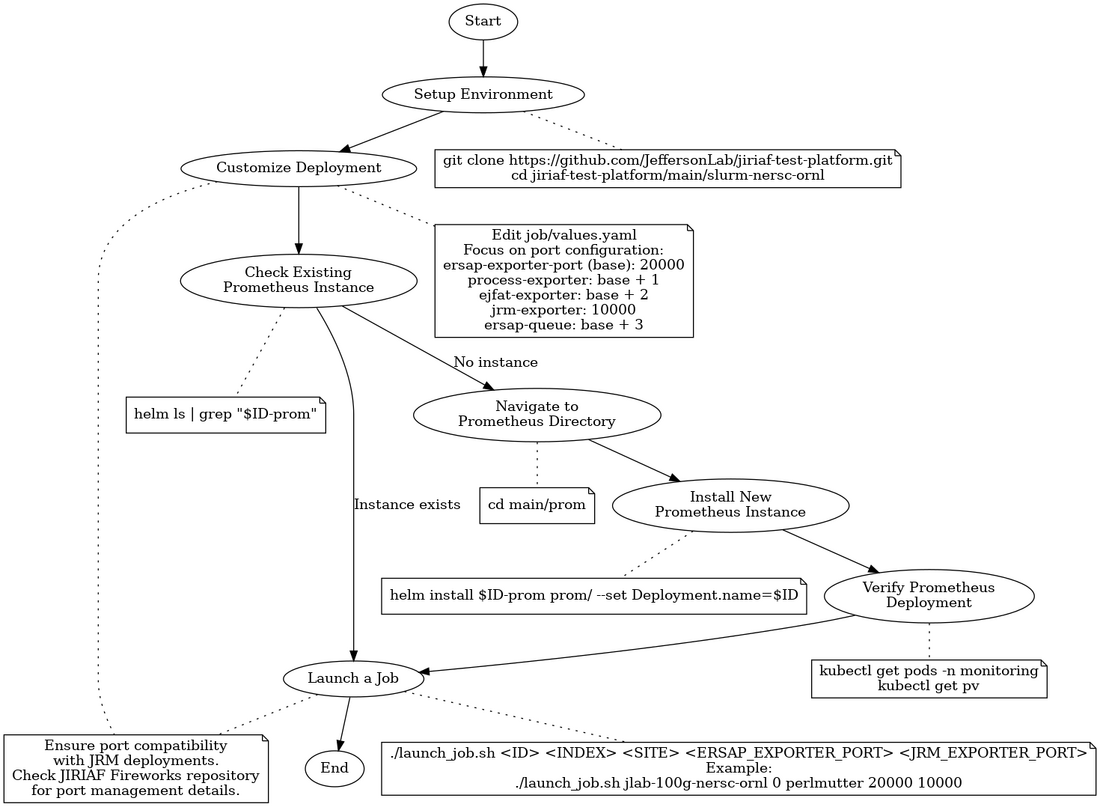Deploy ERSAP data pipelines at NERSC and ORNL via JIRIAF
Step-by-Step Guide: Using slurm-nersc-ornl Helm Charts
Prerequisites
- Helm 3 installed
- Kubernetes cluster access
- kubectl configured
Overview Flow Chart
The following flow chart provides a high-level overview of the process for using the slurm-nersc-ornl Helm charts:
This chart illustrates the main steps involved in deploying and managing jobs using the slurm-nersc-ornl Helm charts, from initial setup through job submission.
Step 1: Understand the Chart Structure
The main chart is in the `job/` directory. Key files:
- `Chart.yaml`: Chart metadata
- `values.yaml`: Default configuration
- `templates/`: Contains all template files
Step 2: Customize the Deployment
- Open `job/values.yaml`
- Edit key settings, focusing on port configuration:
ersap-exporter-port (base): 20000
│
├─ process-exporter: base + 1 = 20001
│
├─ ejfat-exporter: base + 2 = 20002
│
├─ jrm-exporter: 10000 (exception)
│
└─ ersap-queue: base + 3 = 20003
This structure allows easy scaling and management of port assignments.
Step 3: Launch a Job
Use the `launch_job.sh` script:
- Open a terminal
- Navigate to the chart directory
- Run:
./launch_job.sh <ID> <INDEX> <SITE> <ERSAP_EXPORTER_PORT> <JRM_EXPORTER_PORT>
Example:
./launch_job.sh jlab-100g-nersc-ornl 0 perlmutter 20000 10000
Custom Port Configuration (if needed):
- Edit `launch_job.sh`
- Replace port calculations with desired numbers:
ERSAP_EXPORTER_PORT=20000
PROCESS_EXPORTER_PORT=20001
EJFAT_EXPORTER_PORT=20002
ERSAP_QUEUE_PORT=20003
- Save and run the script as described above
Step 4: Submit Batch Jobs (Optional)
For multiple jobs:
- Use `batch-job-submission.sh`:
./batch-job-submission.sh <TOTAL_NUMBER>
- Script parameters:
* `ID`: Base job identifier (default: "jlab-100g-nersc-ornl")
* `SITE`: Deployment site ("perlmutter" or "ornl", default: "perlmutter")
* `ERSAP_EXPORTER_PORT_BASE`: Base ERSAP exporter port (default: 20000)
* `JRM_EXPORTER_PORT_BASE`: Base JRM exporter port (default: 10000)
* `TOTAL_NUMBER`: Total jobs to submit (passed as argument)
Note: Ensure port compatibility with JRM deployments. Check the JIRIAF Fireworks repository for details on port management.
Understand Key Templates
Familiarize yourself with:
- `job-job.yaml`: Defines Kubernetes Job
- `job-configmap.yaml`: Contains job container scripts
- `job-service.yaml`: Exposes job as Kubernetes Service
- `prom-servicemonitor.yaml`: Sets up Prometheus monitoring
Site-Specific Configurations
The charts support Perlmutter and ORNL sites. Check `job-configmap.yaml`:
{{- if eq .Values.Deployment.site "perlmutter" }}
shifter --image=gurjyan/ersap:v0.1 -- /ersap/run-pipeline.sh
{{- else }}
export PR_HOST=$(hostname -I | awk '{print $2}')
apptainer run ~/ersap_v0.1.sif -- /ersap/run-pipeline.sh
{{- end }}
Monitoring
The charts set up Prometheus monitoring. The [`prom-servicemonitor.yaml`](main/slurm-nersc-ornl/job/templates/prom-servicemonitor.yaml) file defines how Prometheus should scrape metrics from your jobs.
Check and Delete Deployed Jobs
To check the jobs that are deployed, use:
helm ls
To delete a deployed job, use:
helm uninstall $ID-job-$SITE-<number>
Replace `$ID-job-$SITE-<number>` with the name used during installation (e.g., `$ID-job-$SITE-<number>`).
Troubleshooting
- Check pod status: `kubectl get pods`
- View pod logs: `kubectl logs <pod-name>`
- Describe a pod: `kubectl describe pod <pod-name>`
